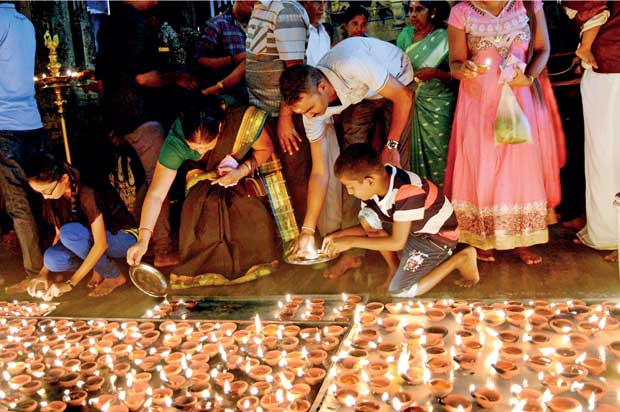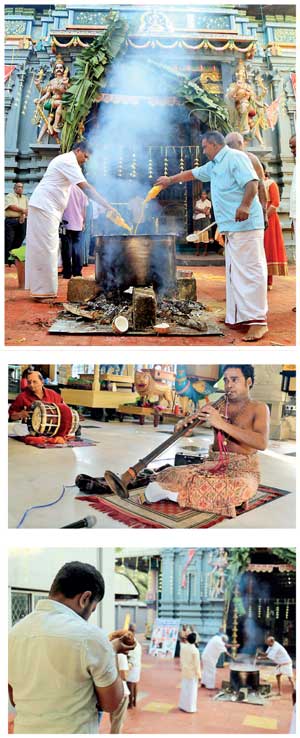Reply To:
Name - Reply Comment

 Thai Pongal is a thanksgiving ceremony celebrated by farmers in particular to thank the nature spirit, the sun and farm animals for bringing prosperity in agriculture with plentiful harvests. They venerate and thank the sun god and offer the first part of the produce in the form of cooked rice.
Thai Pongal is a thanksgiving ceremony celebrated by farmers in particular to thank the nature spirit, the sun and farm animals for bringing prosperity in agriculture with plentiful harvests. They venerate and thank the sun god and offer the first part of the produce in the form of cooked rice.
The feast of the month of Thai celebrated by rice producers and eaters
The recipients of this thanksgiving are farm animals, including the cow, ox and the buffalo. Meanwhile, rice eaters are obliged to thank farmers in addition to the sun god and farm animals for producing their staple food crop. The feast of the month of Thai is therefore an occasion celebrated not only by Tamils the world over but is probably the most popular Hindu festival celebrated to announce the approach of a plentiful harvest.
Epoch of Thai Pongal 
Thai is the first month of the Tamil calendar. Since Thai is an occasion to celebrate plentiful harvests, the festive season falls during the period when the sun enters the zodiac sign of Capricorn (Makara).
Thus the Rice Harvest coincides with this and Thai Pongal is celebrated after the solstice and on the first day of the Tamil calendar i.e. the first day of the month of Thai.
Krishna lifting the Govinda Mountain on his little finger
According to legends, this was the occasion during which Krishna lifted the Govinda Mountain on his little finger to save the people from being washed away by rains and floods.
Meaning of Thai Pongal
As mentioned earlier, Thai is the first month on the Tamil calendar. Pongal is the act of boiling to overflow. In other words, Thai Pongal is the preparation and enjoyment of the first rice meal of the year. On the one hand, this is a celebration of the achievements of the previous year along with wishes of prosperity for the New Year.
“Pongal O Pongal, we are getting exactly what we expected”
The rituals of this family festival begin with the boiling of a pot of rice at sunrise at the front doorstep of the house. Each family member gathers around the pot of rice. They wish one another with the cry “Pongal O Pongal, we are getting exactly what we expected, it is boiling, it is boiling.”
The dish called Pongal
The rice is cooked and prepared as a dish called Pongal, made of Dhal and sugar. There is also a Pongal variety called Ven Pongal. “Ven” means white. Another variety called Chakkarai Pongal is prepared with Dhal and jaggery. Chakkarai means sweet. Together with Ven Pongal, Vadai, Idly and spicy condiments are consumed.
Purpose of the Festival
The main purpose of the ceremony is to encourage social cohesiveness, the building of unity and harmony among people and most importantly, to recognize the services rendered by the farmer. Pongal is the name of the four-day thanksgiving festival.
Legends connected with Thai Pongal
Thai Pongal has many legends. The most popular is the story of Lord Krishna lifting the Govinda Mountain to save his people.
An interesting story related to Thai Pongal says God had instructed his ox Nandi to request his devotees to have an oil bath daily and to consume food twice a week. However, Nandi mixed it up and requested the people to eat daily and bathe twice a week. Lord Shiva was annoyed and said “Now the people need to eat more, you stay on earth and help them to plough the land more”.
Thai Pongal – a four day festival
Thai Pongal is a three to four day festival. A number of elements contribute to make the crops abundant. The sun provides energy, in the process of food production. The rain provides water. Farm animals help in tilling and preparing the land for agriculture and the farmer makes use of all these to make the harvest plentiful.
Bhogi Pongal
The first day of the festival which falls on the last day of the Tamil month Margshi is called Bhogi. Bhogi is dedicated to Indra (Bhogi), the god of clouds and rain.
Bhogi Pongal- a day for the family
On this day people clean their houses from top to bottom and collect unwanted goods. In the evening, people light bonfires and burn whatever should be disposed of. Homes are washed, decorated, doorways are painted with vermilion and Sandalwood paste with colourful garlands of leaves and flowers decorating the exteriors. Bhogi, the rain god is worshipped.
In India where the majority of the population are farmers, this celebration is the withdrawal of the South east monsoons and the reaping of a bountiful harvest.
Pongal pooja is generally offered in an open courtyard. It is cleaned and smeared with cow dung a day before the festival.
Suriya Pongal
The second day is Suriya Pongal, during which offerings are made to the sun god and the rain god.
In fact, this is the festival proper where certain customs are followed in anticipation of a new life for everyone blessed with plentiful harvests. The ritual festivities begin early in the morning. Every family member gets up early in time to participate in the festival. They bathe and dress well and gather at the front steps of the house or in the front garden (mutt ram).
Preparation of the first Pongal meal
A senior member of the family, the mother, grandmother or father conducts the cooking. The other members assist him or her. When the water is boiled sufficiently, the rice is put into the pot. Those who can afford it prepare special dishes. In addition to cow’s milk or coconut milk, Dhal, jaggery or chakkarai, kalkandu, roasted green gram (payuru), raisins, cashew nuts and cardamom pods are added to the dish.
When the meal is ready, family members lay plantain leaves on the floor at the doorstep and place the pudding on the leaves. Before taking the meal, they say a prayer.
Kolams (Rangoli)
Kolams are designs created in the front yards of houses using rice flour paste. Presumably, the idea is to provide food for ants and other insects. At the centre is a lump of cow dung, holding a five petal pumpkin flower as a symbol of fertility. These decorations are made as a form of purification.
Maattu Pongal
The third day is the Pongal for farm animals. Farmers are well aware of the fact that prosperity in the field of agriculture depends largely on the assistance provided by farm animals including the cow, the ox and the buffalo who help the farmer till the land.
These animals also provide fertilizer for the farmland. Hence the farm animal is an assistant, a friend and close associate of the farmer. On the Maattu Pongal day, domestic cattle are bathed, anointed and fed to their heart’s content. They are adorned with garlands of freshly picked flowers around their necks. In South India there was a custom to hang bags of valuable objects around the horns of buffaloes and challenge young men to remove them. Young men wrest with the buffaloes often with success.